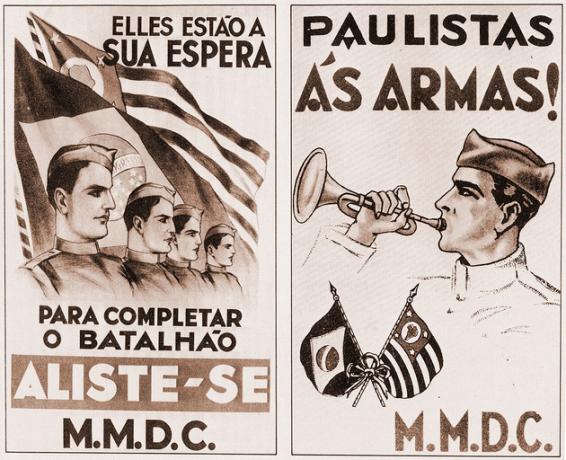THE Constitutionalist Revolution of 1932 it was a revolt that took place in the state of São Paulo against the government of Getúlio Vargas.
The São Paulo elites sought to regain the political command they had lost with the 1930 Revolution, calling for elections to be called and a Constitution to be promulgated.
The day of the Constitutionalist Revolution is celebrated on July 9th and is a public holiday in the state of São Paulo.
Causes of the 1932 Revolution
The 1930 Revolution deposed President Washington Luís (1869-1947) and prevented Júlio Prestes from taking office (1882-1946), taking Getúlio Vargas to power.
Although they had lost their political hegemony, the Paulistas supported Vargas with the hope that he would call elections for the Constituent Assembly and for president.
However, time passed and that did not happen. In this way, a strong opposition to the Vargas government was initiated by São Paulo farmers.
In addition, there was also a large participation of university students, merchants and liberal professionals, who demanded that elections be called.
Thus, on May 23, 1932, a political act in favor of elections took place in downtown São Paulo. The police repress a group of protesters and cause the death of four students: Martins, Miragaia, Dráusio and Camargo.
The fact revolts the society of São Paulo and the initials of young people - M.M.D.C. - become one of the symbols of movement.
Summary of the Constitutionalist Revolution of 1932
For many historians, the term "revolution" for the 1932 constitutionalist movement is not the most appropriate. This is because it was a movement planned by the elites, the term "revolt" being better suited to describe it.
Anyway, the Constitutionalist Revolution of 1932, 1932 revolution or Paulista War it was the first major uprising against the Getúlio Vargas administration and also the last major armed conflict that took place in Brazil.
The movement was a response from São Paulo to the Revolution of 1930, which ended the autonomy of the states guaranteed by the Constitution of 1891.
The insurgents demanded that the Provisional Government draw up a new constitution and call for elections for president.
Mobilization for the Constitutionalist Revolution

The revolt began on July 9 and was led by the interventor of the state - a position equivalent to that of governor - Pedro de Toledo (1860-1935).
The people from São Paulo carried out a great campaign using newspapers and radios, managing to mobilize a good part of the population.
There were more than 200,000 volunteers, 60,000 of which were combatants. On the other hand, while the movement was gaining popular support, 100,000 soldiers from the Vargas government left to face the São Paulo.
military combats
The paulistas expected the support of Minas Gerais and Rio Grande do Sul. However, both states did not join the cause.
Before long, São Paulo, which was planning a rapid offensive against the capital, found itself surrounded by federal troops. So, they appealed to the population to donate gold in order to buy armaments and feed the troops.
In total, there were 87 days of fighting, from 9 July to 4 October 1932, with the last clashes occurring two days after the São Paulo surrender.
On October 2, in the city of Cruzeiro, the troops from São Paulo surrender to the leader of the federal offensive and on the following day, October 3, they sign the surrender.
Consequences of the Constitutionalist Revolution
An official balance of 934 dead was recorded, although unofficial estimates report up to 2200 dead. Despite the defeat on the battlefield, politically the movement achieved its goals.
The struggle for the constitution was strengthened and, in 1933, elections were held, placing the civilian Armando Sales (1887-1945) as State Governor in 1935.
Likewise, in 1934 the Constituent Assembly that would make the new Magna Carta of the country, promulgated in the same year, was convened. This would be the shortest of the constitutions that Brazil has ever had, as it was suspended with the coup that instituted the Estado Novo in 1937.
Until today, the 9th of July is a date commemorated throughout the state of São Paulo and remembered in several monuments.
The Ibirapuera Obelisk, for example, is the movement's funerary monument and houses the remains of those who died in the Revolution. There are also the bodies of Martins, Miragaia, Dráusio and Camargo.
Read too: 1934 Constitution


